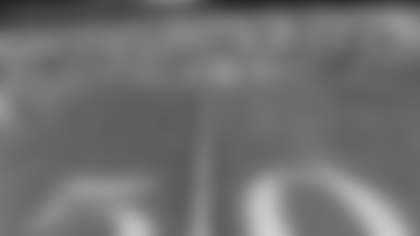Ready or not, here it comes:
• Did you ever celebrate New Year's Eve in an airport? This is a story about the time the Pittsburgh Steelers traveling party was walking through the Greater Pittsburgh International Airport when the ball dropped and ended the 1980s.
• It all began nine months earlier in the glorified boiler room that passed for an NFL weight room the Steelers used during their days at Three Rivers Stadium. It was the start of the offseason program leading up to the 1989 season, and if there was one thing about their young quarterback, Bubby Brister, he knew how to make an entrance.
• The previous summer, Brister had arrived at Saint Vincent College for what was going to be a camp-long battle with Todd Blackledge for the starting quarterback job and proclaimed to the media, "I'm the man, write it down."
• This time, Brister walked up to the old-school green slate board, picked up a piece of chalk and scrawled, "PLAYOFFS!"
• The 1989 Steelers had a lot of things to figure out before they would be ready for a playoff chase, and the figuring out didn't go smoothly.
• The Steelers went through a preseason that included a lot of growing pains and the holdout of wide receiver Louis Lipps, but on the eve of the regular season opener, Noll was optimistic. "We've learned some things. We've made some progress at times, and other times we've faltered. We've got a lot more to learn, but we're going to be all right eventually. We've got a lot of young people who want it, and that's a big part of it."
• Evidently, the key word there was "eventually," because the season's first two weeks were brutal for this young team and its veteran coach.
• In the opener against the Browns at Three Rivers Stadium, the Steelers committed eight turnovers, allowed six sacks, and generally did nothing right in what still is the biggest defeat in franchise history, 51-0. Three of the turnovers were returned directly for touchdowns and two more set up an easy 10 points. The Browns led, 30-0, at halftime and only attempted one pass in the entire second half so as to keep the clock running, which reflected the deep respect Cleveland coach Bud Carson had for Noll.
• The next week, the Steelers traveled to Cincinnati and quickly fell behind, 20-3. Brister threw a touchdown pass to rookie Derek Hill to make it, 20-10, and on the ensuing possession Thomas Everett intercepted Boomer Esiason and returned the ball to the Bengals 22-yard line. But Dwayne Woodruff was flagged for pass interference to nullify the play, and the Bengals drove for a touchdown to make it, 27-10. The Steelers were penalized 12 times for 144 yards and lost, 41-10.
• For the mathematically impaired, that's two games, two losses, 92-10 aggregate score.
• "Either the Super Bowl champion comes out of the AFC Central," said Noll, "or we're in for a long season."
• All of a sudden, the Steelers were besieged by the national media, but this time the questions being asked were about Noll's competence. NBC, the network that televised the AFC, sent O.J. Simpson to Pittsburgh for a few days to see what he could unearth. The Minnesota Vikings, a playoff team in each of the previous two seasons and a favorite to make it three in a row, were next on the Steelers' schedule, and this seemed to guarantee that 0-2 would become 0-3.
• "The big thing is, do you cower in a corner?" said Noll. "Do you put your tail between your legs and run away? Or do you face up to it and be a man about it? Last year we had guys who wouldn't face a challenge … and they aren't here anymore. The one thing about this football team I'm happy about is it has shown some tough-mindedness, and that's an important element. If it carries through, which it should, we should be able to get things done."
• Noll wasn't about to cower in a corner, or put his tail between his legs and run away. An argument can be made that 1989 proved to be Noll's best season, and the first big piece of evidence to support that was the Steelers' 27-14 win over the Vikings. "This wasn't a mirage. We did it," said Noll. "Now we have to do it consistently."
• But instead of consistency, the 1989 Steelers then embarked on a months-long roller coaster ride. From Oct. 1 through Nov. 5, the Steelers were on a win one, lose one pattern, and then things changed for the next month but not really. During those four weeks, they won two and then lost two, and when Dec. 1 rolled around they were 6-6. They lost their first game in December to drop to 6-7 when referee Ben Dreith lost count of Houston's timeouts in the first half, and the extra one he awarded the Oilers allowed them to score a touchdown in what turned out to be a 23-16 defeat for the Steelers.
• Rebounding the next week to shut out the Jets and get back to .500 at 7-7, the Steelers found themselves in the thick of an AFC race in which only one of the conference's teams would finish with double-digit wins. "On Saturday (before the Jets game), Chuck said, 'I don't know what everybody's thinking, but we're still in the hunt for the playoffs,'" said Merril Hoge. 'We're still in it and don't anybody believe we're not.'"
• The Steelers were in it, but this is what they needed to happen to make it: They had to win out – vs. New England and at Tampa Bay – and the Browns, Bengals, Dolphins, Colts and Chiefs all had to lose at least one of their two games.
• The improbable happened, and the Steelers qualified, but it seemed as though their stay in the postseason would be short. They were being sent to Houston for a third game against the Oilers, which would be played on Sunday, Dec. 31, and on the Friday before kickoff Rod Woodson was in the hospital with the flu and a concussion. Earlier in the season, the Steelers were shut out, 27-0, in Houston.
• Woodson's health was such that team doctors initially decided to leave him in Pittsburgh, but Dan Rooney intervened. When he was assured Woodson's condition would get no worse because of a trip to Houston, Rooney refused to approve any plan that left his best player behind for the franchise's first playoff game in five years. Woodson would make the trip, and a decision on his availability would be made prior to kickoff.
• This time in the Astrodome, the events of the game favored the Steelers, especially early. Tim Worley's 9-yard touchdown run gave the Steelers a 7-0 lead, and while the Oilers were moving the ball they continually stalled in the red zone. Their only scores through the first three quarters came on Tony Zendejas field goals of 26, 35, and 26 yards.
• Eventually, the Steelers defense began to tire, and Warren Moon and Ernest Givins combined on two touchdown passes in the fourth quarter to give the Oilers a 23-16 lead. When the Steelers got the ball for their last best chance to tie the game, they were at their 18-yard line with 6:02 to play.
• To that point, Brister had been 11-for-28, but then he caught fire. He completed 4-of-5, a reverse to Dwight Stone gained 22 yards, and Hoge capped it off with a 2-yard touchdown run with 46 seconds left. After Gary Anderson's PAT, it was 23-23.
• The Steelers won the toss in overtime but were forced to punt, and a poor kick by Harry Newsome found the Oilers offense taking the field with the ball at the 50-yard line. It looked like the game was soon to be over.
• It was, but not in the way everyone believed.
• Moon had completed 29-of-48 for 315 yards; Givens had 11 catches for 136 yards, and Drew Hill had six for 98 more. But for some reason, the Oilers thought it would be a good idea to run Lorenzo White on first down.
• Let Woodson take it from there: "I saw it was a run, and I saw (defensive end) Timmy Johnson coming from the left side, and he was pinning White to the sideline. I came up, and the first thing that went through my head was to hit him in the numbers. I lowered my pads and hit him, and I didn't know the ball was out until I felt something on my leg. I turned around, and it was the ball, so I grabbed it and tried to run."
• By the way, Woodson's fever had gone down, and he started and played every snap on defense and returned kicks. And what he did in overtime was an incredible play by a great player at a critical moment. To put it in its rightful place in franchise history, this was the defensive version of the Immaculate Reception.
• The Steelers offense came on and gained 14 yards to move the ball to the Oilers 33-yard line, where it faced a third-and-8. As the play was being sent to Brister, Noll switched his headset over to defense, and told defensive coordinator Rod Rust, "If we don't make this, we're going to punt and pin them deep."
• Rust answered, "I don't know if we can stop them again."
• It was a startling admission by a successful coach in an ultra-competitive business, but it also was right on the money, and he offered it to Noll at a critical stage where a bigger ego might have gotten in the way. But whatever else Rust's admission was, it was something that needed to be said.
• It says as much about Noll that he responded to Rust's assessment and sent Anderson onto the field to attempt a 50-yard field goal after that third-down pass fell incomplete. Anderson's kick was down the middle and into the net. Game over.
• "Our guys were tired. Our guys were starting to cramp up," said Lloyd. "It was a situation where we knew if Gary didn't make it, we'd have to go out there and stop them again. I don't know …"
• It never came to that, because Chuck Noll listened to some advice, and because Dan Rooney did not.
• When the Steelers charter landed in Pittsburgh, it was still 1989. But after the team de-planed and began walking through the airport toward the parking lot, all of the lights in the terminal flashed on and off a handful of times.
• It had just become 1990. And a Happy New Year it was.














